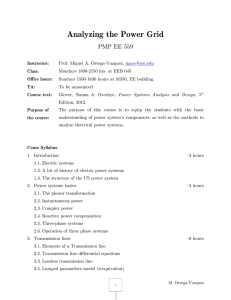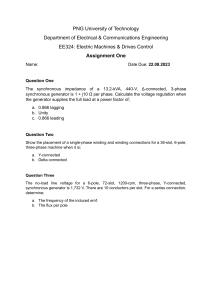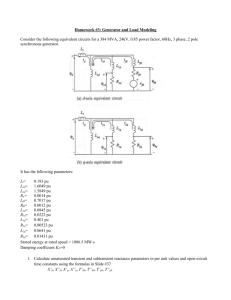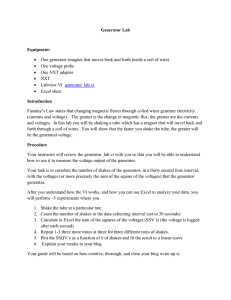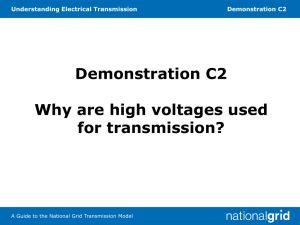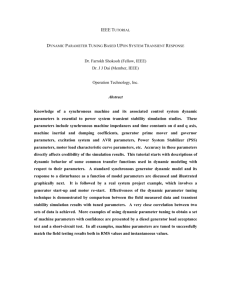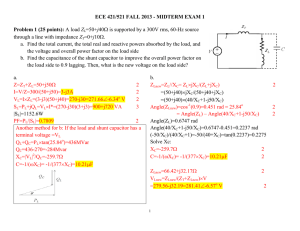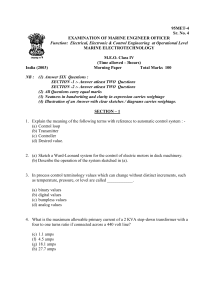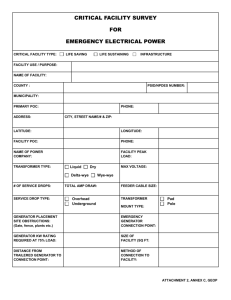Pearson Techonology Group
advertisement
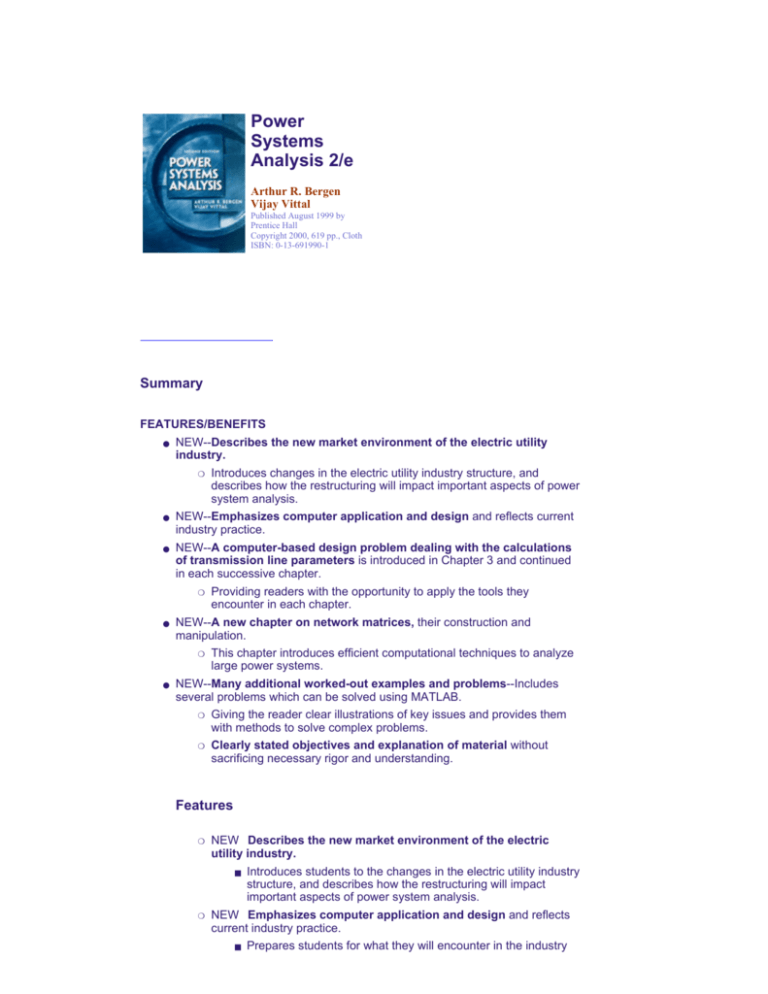
Power Systems Analysis 2/e Arthur R. Bergen Vijay Vittal Published August 1999 by Prentice Hall Copyright 2000, 619 pp., Cloth ISBN: 0-13-691990-1 Summary FEATURES/BENEFITS ● NEW--Describes the new market environment of the electric utility industry. ❍ Introduces changes in the electric utility industry structure, and describes how the restructuring will impact important aspects of power system analysis. ● NEW--Emphasizes computer application and design and reflects current industry practice. ● NEW--A computer-based design problem dealing with the calculations of transmission line parameters is introduced in Chapter 3 and continued in each successive chapter. ❍ ● NEW--A new chapter on network matrices, their construction and manipulation. ❍ ● Providing readers with the opportunity to apply the tools they encounter in each chapter. This chapter introduces efficient computational techniques to analyze large power systems. NEW--Many additional worked-out examples and problems--Includes several problems which can be solved using MATLAB. ❍ Giving the reader clear illustrations of key issues and provides them with methods to solve complex problems. ❍ Clearly stated objectives and explanation of material without sacrificing necessary rigor and understanding. Features ❍ NEW Describes the new market environment of the electric utility industry. ■ ❍ Introduces students to the changes in the electric utility industry structure, and describes how the restructuring will impact important aspects of power system analysis. NEW Emphasizes computer application and design and reflects current industry practice. ■ Prepares students for what they will encounter in the industry and teaches them techniques to solve problems efficiently. ❍ NEW A computer-based design problem dealing with the calculations of transmission line parameters is introduced in Chapter 3 and continued in each successive chapter. Students can use available software or develop software using MATLAB. ■ ❍ NEW A new chapter on network matrices, their construction and manipulation. ■ ❍ Gives students clear illustrations of key issues and provides them with methods to solve complex problems. Clearly stated objectives and explanation of material without sacrificing necessary rigor and understanding. ■ ❍ This chapter introduces efficient computational techniques to analyze large power systems. NEW Many additional worked-out examples and problems Includes several problems which can be solved using MATLAB. ■ ❍ Provides students with the opportunity to apply the tools they encounter in each chapter. Helps students to more easily understand the material, and assists professors in explaining the material. For additional; resources visit the book's Website at http://www.prenhall.com/Bergen. Table of Contents 1. Background. Introduction. Electric Energy. Fossil-Fuel Plant. Nuclear Power Plant. Hydroelectric Power Plant. Other Energy Sources. Transmission and Distribution Systems. The Deregulated Electric Power Industry. 2. Basic Principles. Introduction. Phasor Representation. Complex Power Supplied to a One-Port. Conservation of Complex Power. Balanced Three-Phase. Per Phase Analysis. Balanced Three-Phase Power. Summary. 3. Transmission-Line Parameters. Introduction. Review of Magnetics. Flux Linkages of Infinite Straight Wire. Flux Linkages; Many-Conductor Case. Conductor Bundling. Transposition. Impedance of Three Phase lines Including Ground Return. Review of Electric Fields. Line Capacitance. Determination of Line Parameters Using Tables. Typical Parameter Values. Summary. 4. Transmission-Line Modeling. Introduction. Derivation of Terminal V, I Relations. Waves on Transmission Lines. Transmission Matrix. Lumped-Circuit Equivalent. Simplified Models. Complex Power Transmission (Short Line). Complex Power Transmission (Radial Line). Complex Power Transmission (Long or Medium Lines). Power-Handling Capability of Lines. Summary. 5. Transformer Modeling and the Per Unit System. Introduction. Single-Phase Transformer Model. Three-Phase Transformer Connections. Per Phase Analysis. Normal Systems. Per Unit Normalization. Per Unit Three-Phase Quantities. Change of Base. Per Unit Analysis of Normal System. Regulating Transformers for Voltage and Phase Angle Control. Autotransformers. Transmission Line and Transformers. Summary 6. Generator Modeling I (Machine Viewpoint). Introduction. Classical Machine Description. Voltage Generation. Open-Circuit Voltage. Armature Reaction. Terminal Voltage. Power Delivered by Generator. Synchronizing Generator to an Infinite Bus. Synchronous Condensor. Role of Synchronous Machine Excitation in Controlling Reactive Power. Summary. 7. Generator Modeling II (Circuit Viewpoint). Introduction. Energy Conversion. Application to Synchronous Machine. The Park Transformation. Park's Voltage Equation. Park's Mechanical Equation. Circuit Model. Instantaneous Power Output. Applications. Synchronous Operation. Steady-State Model. Simplified Dynamic Model. Generator Connected to Infinite Bus (Linear Model). Summary 8. Generator Voltage Control. Introduction. Exciter System Block Diagram. Generator Models. Stability of Excitation System. Voltage Regulation. Generator Connected to Infinite Bus. Summary. 9. Network Matrices. Introduction. Bus Admittance Matrix. Network Solution. Network Reduction (Kron Reduction). YBUS Structure and Manipulation. Bus Impedance Matrix. Inverse Elements to Determine Columns of ZBUS. Summary. 10. Power Flow Analysis. Introduction. Power Flow Equations. The Power Flow Problem. Solution by Gauss Iteration. More General Iteration Scheme. Newton-Raphson Iteration. Application to Power Flow Equations. Decoupled Power Flow. Control Implications. Regulating Transformers in Power Flow Analysis, Power Flow Solutions for Large Power Systems. Summary. 11. Automatic Generation Control and the New Market Environment. Introduction. Power Control System Modeling. Application to Single Machine-Infinite Bus System. Simplified Analysis of Power Control System. Power Control, Multigenerator Case. Special Case; Two Generating Units. Division of Power System Into Control Areas. Formulation of the Economic Dispatch Problem. Classical Economic Dispatch (Line Losses Neglected). Generator Limits Included. Line Losses Considered. Calculation of Penalty Factors. Economic Issues and Mechanisms in the New Market Environment. Transmission Issues and Effects in the New Market Environment. Summary. 12. Unbalanced System Operation. back to top Introduction. Symmetrical Components. Use of Symmetrical Components for Fault Analysis. Sequence Network Connections for Different Types of Faults. More General Fault Circuit Analysis. Power From Sequence Variables. Sequence Representation of Y and …D Connected Circuits. Generator Models for Sequence Networks. Transformer Models for Sequence Networks. Sequence Representation of Transmission Lines. Assembly of Sequence Networks. Fault Analysis for Realistic Power System Model. Matrix Methods. Summary. 13. System Protection. Introduction. Protection of Radial Systems. System with Two Sources. Impedance (Distance) Relays. Modified-Impedance Relays. Differential Protection of Generators. Differential Protection of Transformers. Differential Protection of Buses and Lines. Overlapping Zones of Protection. Sequence Filters. Computer Relaying. Summary. 14. Power System Stability. Introduction. Model. Energy Balance. Linearization of Swing Equation. Solution of Nonlinear Swing Equation. Other Applications. Extension to Two-Machine Case. Multimachine Application. Multimachine Stability Studies. Summary. Appendices. Reluctance. Force Generation in a Solenoid. Method of Lagrange Multipliers. Root-Locus Method. Negative- and Zero-Sequence Impedances of Synchronous Machines. Inversion Formula. Modification of Impedance Matrices. Conductor Characteristics. Selected Bibliography. Index.
